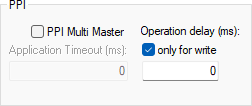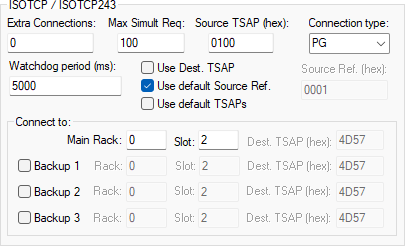This Driver's [P] parameters for configuration are not used. All configurations are performed on the configuration window, shown on the next figure.

MProt tab
The available options for the General group are described on the next table.
Available options on the General group
Option |
Description |
|---|---|
Default Slave Address |
This can be used as the default address for any Tag. Leave the N1 parameter in 0 (zero) so that it is replaced by the default address |
Network |
Protocol selection. Available options are PPI, MPI, ISOTCP, ISOTCP for CPU 243, or MPI for IBHLink converter. The PPI, MPI, or ISOTCP/ISOTCP243 groups on this tab are enabled or disabled according to the selected protocol |
Local Address |
Driver's address on the network. It can be selected arbitrarily |
The available options for the PPI group are described on the next table.

PPI group
Available options on the PPI group
Option |
Description |
|---|---|
PPI Multi Master |
Informs this Driver that there are other Masters on the network |
Application Timeout (ms) |
Maximum communication time for each Tag, in milliseconds. Available only when it is a multi-master |
Operation delay (ms) |
Stop time for an interval between communication operations, in milliseconds. Select the only for write option to apply this interval only for writing operations. For more information, please check the next note |
NOTE |
The Operation delay (ms) option adds a minimum waiting time that must occur between the ending of a reading or writing operation and the beginning of the next one. Use a value different from 0 (zero) on this configuration only if facing communication failures caused by PLC's processing inertia. Writing operations are the most affected ones, because they are usually random, and for these operations there is the only for write option. If this option is not selected, the waiting time applies to reading and writing operations. If it is selected, it only applies to writing operations, which is recommended. Notice that adding a waiting time may slow down application's performance. |
The available options for the MPI group are described on the next table.

MPI group
Available options on the MPI group
Option |
Description |
|---|---|
Highest Station Address |
Indicates the greatest available address on the network, so that in PPI and MPI modes this Driver discovers other possible Masters on the network. Only the 15, 31, or 63 values must be added |
Profibus Speed |
Nominal speed of a Profibus network |
The available options for the ISOTCP / ISOTCP243 group are described on the next table.

ISOTCP / ISOTCP243 group
Available options on the ISOTCP / ISOTCP243 group
Option |
Description |
|---|---|
Extra Connections |
Number of additional TCP connections that can be created to improve communication performance |
Max Simult Req |
Maximum number of simultaneous variables on a single request. This configuration can be used to significantly improve communication performance, as long as users use a value greater than 0 (zero) in the Extra Connections option |
Source TSAP (hex) |
A number formed by a Word in hexadecimal identifying the protocol's local TSAP |
Connection type |
Connection type. Possible values are PG, OP, or PC. It must be selected according to CPU configuration |
Interval in milliseconds for Watchdog Tag's expiration. If this Tag exists and its value does not vary inside this interval, then the Driver performs an IP address switch |
|
Use Dest. TSAP |
If this option is selected, enables typing values for Dest. TSAP. If this option is not selected, enables typing values for Rack, Slot and Connection type |
Use default TSAPs |
If this option is selected, uses default TSAP values and so disables typing configuration values of Source TSAP, Dest. TSAP, Connection Type, Rack, and Slot |
Source Ref. (hex) |
A number formed by a Word in hexadecimal identifying the protocol's source reference. It is only enabled when the Use default Source Ref option is not selected |
Rack |
Destination CPU's rack number |
Slot |
Destination CPU's slot number |
Dest. TSAP (hex) |
A number formed by a Word in hexadecimal identifying the protocol's destination TSAP |
Backup 1 / Backup 2 / Backup 3 |
Enables typing rack and slot values for the respective backup CPU(s), for use in redundancy systems with values different from the main CPU |
For this Driver's communication to work with the Siemens S7-1200 PLC series, users must select the ISOTCP option, deselect the Use default TSAPs option, configure the Source TSAP (hex) property to "0100", and define the Connection type option as "PG", Rack with 0 (zero), and Slot with 1 (one).
NOTES |
•When selecting the ISOTCP or ISOTCP243 protocols, all Tags in the Driver object must have the N1 or B1 parameter in 0 (zero) and the Default Slave Address parameter also in 0 (zero). •The Source Ref and Source TSAP parameters must be considered only in very specific cases. Due to successful executions in a wide range of topologies, it is strongly recommended to always keep the Use default Source Ref selected and the Source TSAP value always as "0100". •When the Use Default TSAPs option is selected together with the ISOTCP protocol, the Source TSAP value is "0100" and the Dest. TSAP value is "0202". •TSAP stands for Transport Service Access Point, which is a terminology used by the ISO protocol. •When using PC - PPI/MPI serial adapters, it is very common the need to configure the handshaking on the Serial tab of Driver's configuration window. Only the RTS control must be configured to ON. If there is any unsuccessful communication during this Driver's initial tests, it is advisable to try that change, RTS Control configured to ON, and execute the test again. |